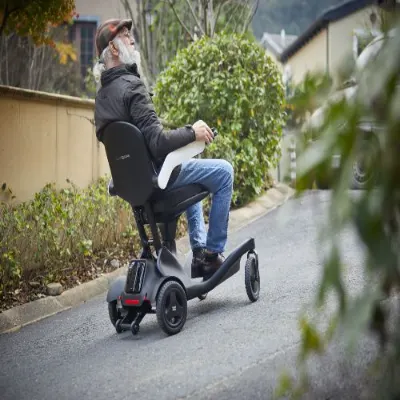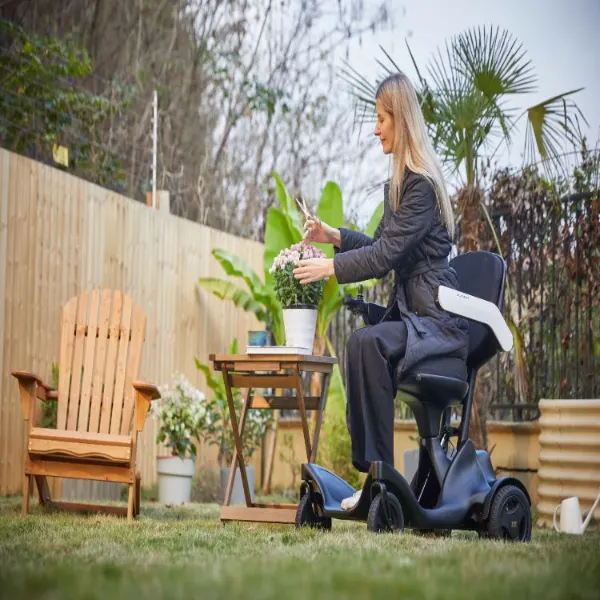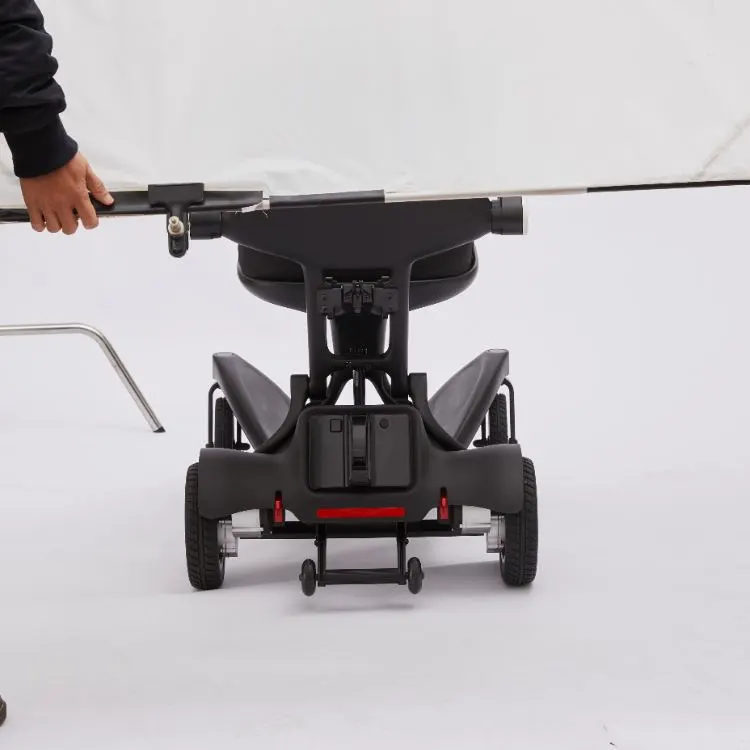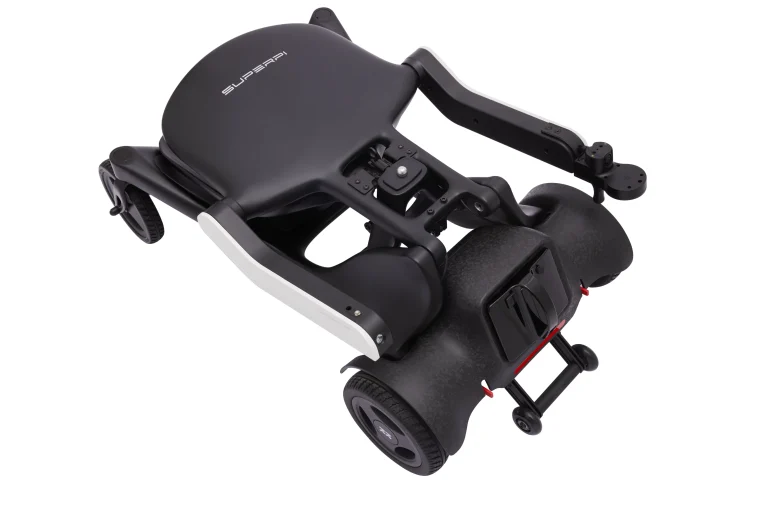
Understanding the Need for Mobility AidsAging often brings physical challenges such as reduced strength, joint pain, or chronic conditions like arthritis, osteoporosis, or neurological disorders. According to the U.S. Census Bureau, approximately 40% of adults aged 65 and older in the U.S. have a disability that impacts mobility, making assistive devices essential for maintaining independence. Mobility aids like scooters and wheelchairs empower seniors to perform daily tasks—such as grocery shopping, visiting friends, or moving around the home—without relying on caregivers.While both electric mobility scooters and traditional wheelchairs address mobility challenges, they cater to different needs and preferences. Mobility scooters are motorized, offering greater range and independence for outdoor use, while wheelchairs, whether manual or powered, are often better suited for indoor environments or users with specific medical needs. To choose the right option, it’s crucial to evaluate the senior’s physical capabilities, lifestyle, and the environments in which the device will be used.
Section 1: Overview of Electric Mobility ScootersWhat Are Electric Mobility Scooters?Electric mobility scooters are battery-powered vehicles designed to assist individuals with limited mobility. They typically feature three or four wheels, a comfortable seat, and a tiller (handlebar) for steering. Scooters are controlled via hand-operated throttles, allowing users to adjust speed and direction easily. They come in various sizes, from compact travel models to heavy-duty scooters built for all-terrain use.Key Features of Mobility Scooters
- Power Source: Powered by sealed lead-acid (SLA) or lithium-ion batteries, offering ranges from 10 to 30 miles per charge.
- Speed: Typically ranges from 3 to 8 mph, with some heavy-duty models reaching up to 11.5 mph.
- Weight Capacity: Varies from 250 to 500 pounds, depending on the model.
- Design: Available in three-wheel (better maneuverability) or four-wheel (greater stability) configurations.
- Portability: Travel scooters are lightweight and foldable, while larger models may require vehicle lifts for transport.
- Comfort: Features padded seats, adjustable tillers, and sometimes suspension systems for a smoother ride.
Types of Mobility Scooters
- Travel/Portable Scooters: Lightweight (under 100 pounds), disassemblable or foldable, ideal for short trips or travel. Example: Pride Go-Go Elite Traveller ($1,200–$1,500).
- Mid-Size Scooters: Versatile for indoor and outdoor use, with a range of up to 20 miles and speeds up to 7 mph. Example: Pride Victory 10 ($1,800–$2,500).
- Heavy-Duty/All-Terrain Scooters: Built for rugged outdoor use, with larger tires, higher ground clearance, and weight capacities up to 500 pounds. Example: Afikim Afiscooter S4 ($5,000–$7,000).
Advantages of Mobility Scooters
- Independence: Enable seniors to travel longer distances without assistance, ideal for errands or outdoor activities.
- Ease of Use: Simple hand controls and adjustable features cater to users with limited dexterity.
- Versatility: Suitable for various terrains, from smooth indoor floors to outdoor sidewalks or gravel paths.
- Comfort: Padded seats, armrests, and suspension systems ensure a comfortable ride, especially for extended use.
- Customization: Accessories like baskets, cup holders, or canopies enhance functionality.
Limitations of Mobility Scooters
- Size and Maneuverability: Larger models may struggle in tight indoor spaces due to wider turning radii (up to 60 inches for heavy-duty scooters).
- Cost: Prices range from $800 to over $7,000, with higher-end models requiring significant investment.
- Battery Dependence: Limited range (10–30 miles) requires regular charging and battery maintenance.
- Learning Curve: Users may need practice to master steering and speed control, especially on uneven terrain.
- Transport Challenges: Larger scooters require vehicle lifts or ramps for transport, adding to costs.
Ideal UsersMobility scooters are best suited for seniors who:
- Have sufficient upper body strength and dexterity to operate hand controls.
- Need to travel moderate to long distances (e.g., shopping, visiting parks).
- Live in environments with accessible outdoor spaces (e.g., paved sidewalks, suburban areas).
- Seek independence and minimal caregiver assistance.
Section 2: Overview of Traditional WheelchairsWhat Are Traditional Wheelchairs?Traditional wheelchairs are mobility devices designed for individuals who cannot walk or have significant mobility limitations. They come in two primary forms: manual wheelchairs, propelled by the user’s arms or a caregiver, and power wheelchairs, which use electric motors for propulsion. Wheelchairs are often prescribed for medical conditions requiring constant mobility support, such as spinal cord injuries or severe arthritis.Key Features of Wheelchairs
- Power Source: Manual wheelchairs rely on human effort, while power wheelchairs use SLA or lithium-ion batteries with ranges of 8–20 miles.
- Speed: Power wheelchairs typically reach 4–6 mph, slower than most scooters.
- Weight Capacity: Ranges from 250 to 450 pounds, with bariatric models supporting up to 600 pounds.
- Design: Compact frames with two large rear wheels (manual) or four/six wheels (power) for stability and maneuverability.
- Portability: Manual wheelchairs are lightweight (15–40 pounds) and foldable; power wheelchairs are heavier (50–250 pounds) and less portable.
- Comfort: Features cushioned seats, adjustable footrests, and sometimes reclining or tilt-in-space options for medical needs.
Types of Wheelchairs
- Manual Wheelchairs: Lightweight (15–40 pounds) or standard models, propelled by the user or a caregiver. Example: Invacare Tracer EX2 ($300–$600).
- Power Wheelchairs: Motorized, with joystick controls, ideal for users with limited upper body strength. Example: Pride Jazzy 600 ES ($3,500–$5,000).
- Specialized Wheelchairs: Designed for specific needs, such as bariatric wheelchairs for heavier users or tilt-in-space models for medical conditions. Example: Karman S-ERGO 115 ($600–$1,200).
Advantages of Wheelchairs
- Compact Design: Smaller turning radii (20–35 inches) make wheelchairs ideal for indoor use in homes or facilities.
- Medical Suitability: Power wheelchairs with tilt, recline, or pressure-relieving seats cater to severe mobility limitations or medical conditions.
- Affordability (Manual): Manual wheelchairs are significantly cheaper ($200–$1,200) than scooters or power wheelchairs.
- Customization: Power wheelchairs offer advanced features like programmable joysticks or elevating seats for specific needs.
- Accessibility: Wheelchairs are widely accepted in public spaces, with ramps and elevators designed for their dimensions.
Limitations of Wheelchairs
- Limited Range: Manual wheelchairs rely on physical effort, which can be exhausting for seniors. Power wheelchairs have shorter ranges (8–20 miles) than scooters.
- Physical Demands (Manual): Require upper body strength, which may not suit seniors with weakness or fatigue.
- Outdoor Limitations: Manual wheelchairs struggle on uneven terrain; power wheelchairs may lack the ground clearance or tire size for rough surfaces.
- Cost (Power): Power wheelchairs ($2,000–$10,000) can be as expensive as or pricier than high-end scooters.
- Transport Challenges: Power wheelchairs are heavy and require vehicle lifts; even lightweight manual wheelchairs may need assistance to load.
Ideal UsersWheelchairs are best suited for seniors who:
- Have significant mobility limitations or medical conditions requiring constant support.
- Primarily need indoor mobility or use in accessible environments (e.g., nursing homes, urban areas).
- Lack the strength or dexterity for manual propulsion (power wheelchairs).
- Require specialized seating or positioning for medical needs.
Section 3: Comparative AnalysisTo help seniors and caregivers choose between a mobility scooter and a wheelchair, we’ll compare the two across key factors: design and functionality, comfort, portability, cost, safety, maintenance, and lifestyle fit.1. Design and Functionality
- Mobility Scooters:
- Structure: Three- or four-wheel design with a tiller for steering. Three-wheel scooters offer tighter turning radii (30–45 inches), while four-wheel models provide stability.
- Controls: Hand-operated throttles and delta tillers, requiring moderate dexterity and strength.
- Terrain: Travel scooters suit smooth surfaces; heavy-duty models handle grass, gravel, or inclines.
- Speed and Range: Faster (up to 8–11.5 mph) with longer ranges (10–30 miles), ideal for outdoor use.
- Use Case: Designed for independent travel over moderate distances, such as errands or outdoor recreation.
- Wheelchairs:
- Structure: Compact frames with two large rear wheels (manual) or four/six wheels (power). Turning radii are smaller (20–35 inches), ideal for tight spaces.
- Controls: Manual wheelchairs require arm strength; power wheelchairs use joysticks, suitable for users with limited hand function.
- Terrain: Manual wheelchairs are limited to smooth surfaces; power wheelchairs can handle some outdoor terrain but lack the ground clearance of scooters.
- Speed and Range: Slower (4–6 mph for power wheelchairs) with shorter ranges (8–20 miles).
- Use Case: Best for indoor use or environments with accessibility features (e.g., ramps, elevators).
Verdict: Scooters excel in outdoor versatility and range, while wheelchairs are better for indoor maneuverability and medical needs.2. Comfort
- Mobility Scooters:
- Seating: Padded, adjustable seats with armrests; some models offer captain’s chairs or swivel seats for easy transfers.
- Ride Quality: Suspension systems in mid-size and heavy-duty scooters smooth out bumps on uneven terrain.
- Legroom: Three-wheel scooters provide more legroom; four-wheel models may feel restrictive for taller users.
- Long-Term Use: Comfortable for extended periods, especially with upgraded seats or suspension.
- Wheelchairs:
- Seating: Cushioned seats with adjustable footrests; power wheelchairs offer tilt, recline, or pressure-relieving seats for medical conditions.
- Ride Quality: Manual wheelchairs lack suspension, leading to a bumpier ride; power wheelchairs may have basic suspension but are less robust than scooters.
- Legroom: Compact designs may limit legroom, but adjustable footrests help.
- Long-Term Use: Power wheelchairs with specialized seating are ideal for prolonged use, especially for medical needs.
Verdict: Scooters offer better comfort for outdoor use and long-distance travel; wheelchairs provide superior seating options for medical conditions but may be less comfortable for extended outdoor use.3. Portability
- Mobility Scooters:
- Travel Scooters: Lightweight (22–100 pounds), foldable, or disassemblable, fitting in car trunks or airline storage.
- Mid-Size/Heavy-Duty Scooters: Heavier (100–300 pounds), requiring vehicle lifts or ramps for transport.
- Storage: Compact scooters fit in apartments; larger models need garage or outdoor storage with weatherproof covers.
- Wheelchairs:
- Manual Wheelchairs: Lightweight (15–40 pounds) and foldable, easily transported in car trunks.
- Power Wheelchairs: Heavier (50–250 pounds), requiring vehicle lifts or ramps; less portable than manual models.
- Storage: Both types fit in small spaces, but power wheelchairs may need charging stations.
Verdict: Manual wheelchairs and travel scooters are the most portable; power wheelchairs and larger scooters are less convenient for transport.4. Cost
- Mobility Scooters:
- Price Range: $800–$7,000, depending on type (travel: $800–$1,500; mid-size: $1,400–$3,000; heavy-duty: $2,000–$7,000).
- Financing: Medicare Part B may cover scooters if medically necessary; private insurance or retailer financing (e.g., Zip’r Mobility) is available.
- Maintenance Costs: Battery replacement ($100–$300 every 1–2 years for SLA), tire maintenance, and occasional servicing.
- Wheelchairs:
- Price Range: Manual wheelchairs ($200–$1,200); power wheelchairs ($2,000–$10,000).
- Financing: Medicare Part B often covers wheelchairs with a prescription and Certificate of Medical Necessity (CMN). Private insurance or VA benefits may also apply.
- Maintenance Costs: Lower for manual wheelchairs (tire and frame maintenance); power wheelchairs require battery replacement ($100–$400) and motor servicing.
Verdict: Manual wheelchairs are the most affordable; scooters and power wheelchairs have comparable costs, but scooters may be cheaper for outdoor-focused models.5. Safety
- Mobility Scooters:
- Stability: Four-wheel scooters are more stable than three-wheel models, especially on uneven terrain. Anti-tip wheels enhance safety.
- Visibility: Headlights, taillights, and reflectors improve visibility; some models include GPS alarms.
- Brakes: Automatic brakes engage when the throttle is released, but users must practice on inclines.
- Regulations: No license required in the U.S., but local laws may limit speed (e.g., 4 mph on sidewalks in some regions).
- Wheelchairs:
- Stability: Power wheelchairs with low centers of gravity are highly stable; manual wheelchairs may tip if not balanced properly.
- Visibility: Power wheelchairs often include lights; manual wheelchairs may require aftermarket reflectors.
- Brakes: Power wheelchairs have automatic brakes; manual wheelchairs rely on user strength or caregiver assistance.
- Regulations: Wheelchairs are widely accepted in accessible spaces, with no licensing requirements.
Verdict: Both devices are safe when used correctly, but scooters require more user training for outdoor use, while wheelchairs are safer in controlled indoor environments.6. Maintenance and Durability
- Mobility Scooters:
- Battery Care: Charge nightly, store above 32°F for lithium-ion batteries, replace every 1–2 years (SLA) or 5–10 years (lithium-ion).
- Tires: Check for wear, especially on outdoor models; replace as needed ($20–$100 per tire).
- Servicing: Annual inspections for brakes, motors, and frames; warranties (e.g., Pride Mobility) cover 1–3 years.
- Durability: Robust for outdoor use but may require weatherproof covers for outdoor storage.
- Wheelchairs:
- Battery Care (Power): Similar to scooters, with regular charging and replacement every 1–2 years.
- Tires: Manual wheelchair tires are durable but may need replacement ($10–$50); power wheelchair tires are sturdier but costlier.
- Servicing: Manual wheelchairs require minimal maintenance (frame and wheel checks); power wheelchairs need motor and joystick servicing.
- Durability: Built for frequent use, especially power wheelchairs, but less suited for rough outdoor conditions.
Verdict: Manual wheelchairs require the least maintenance; scooters and power wheelchairs have similar upkeep but scooters face more wear from outdoor use.7. Lifestyle Fit
- Mobility Scooters:
- Best For: Active seniors who want to travel independently for errands, social outings, or outdoor recreation. Ideal for suburban or rural settings with paved or uneven terrain.
- Examples: A senior living in a suburban home who enjoys park visits or shopping trips might choose a Pride Victory 10 for its versatility.
- Wheelchairs:
- Best For: Seniors with significant mobility limitations or medical needs, primarily navigating indoor spaces or urban areas with accessibility features.
- Examples: A senior in a nursing home or urban apartment with severe arthritis might prefer a Pride Jazzy 600 ES for its compact design and medical seating options.
Verdict: Scooters suit active, independent seniors; wheelchairs are better for those with medical needs or indoor-focused lifestyles.
Section 4: Key Considerations for Choosing Between Scooters and WheelchairsTo make an informed decision, consider the following factors:1. Physical Capabilities
- Scooters: Require moderate upper body strength, dexterity, and balance to operate hand controls and steer. Not suitable for seniors with severe weakness or tremors.
- Wheelchairs: Manual wheelchairs demand significant upper body strength; power wheelchairs are ideal for those with limited strength or dexterity, using joystick controls.
2. Environment
- Scooters: Excel in outdoor settings with paved sidewalks, parks, or uneven terrain (for heavy-duty models). Less ideal for small homes due to larger turning radii.
- Wheelchairs: Designed for indoor use in homes, nursing facilities, or urban areas with ramps and elevators. Limited on rough terrain.
3. Lifestyle and Activities
- Scooters: Support active lifestyles, enabling errands, social visits, or travel. Accessories like baskets or oxygen tank holders enhance functionality.
- Wheelchairs: Better for sedentary or medically complex users, with features like tilt-in-space seating for pressure relief or prolonged sitting.
4. Budget
- Scooters: Affordable travel models ($800–$1,500) are comparable to manual wheelchairs; heavy-duty scooters can match power wheelchair costs.
- Wheelchairs: Manual wheelchairs are the cheapest option; power wheelchairs are expensive but often covered by Medicare for medical necessity.
5. Transport and Storage
- Scooters: Travel scooters are highly portable; larger models require vehicle lifts or outdoor storage.
- Wheelchairs: Manual wheelchairs are the most portable; power wheelchairs need lifts but fit in smaller indoor spaces.
6. Accessibility and Public Use
- Scooters: Accepted in most public spaces but may face challenges in tight areas (e.g., small stores). Check local regulations for sidewalk or road use.
- Wheelchairs: Universally accepted in accessible spaces, with public infrastructure (ramps, elevators) designed for their dimensions.
7. Medical Needs
- Scooters: Limited medical customization, best for general mobility support.
- Wheelchairs: Power wheelchairs offer advanced seating and positioning for conditions like spinal cord injuries or pressure ulcers.
Section 5: Practical Scenarios and RecommendationsTo illustrate how to choose between a scooter and a wheelchair, here are three scenarios:
- Active Senior in a Suburban Setting:
- Profile: A 70-year-old with mild arthritis who enjoys shopping, visiting parks, and traveling occasionally.
- Recommendation: A mid-size mobility scooter like the Pride Victory 10 (4-wheel, 7 mph, 18-mile range, ~$2,000). Its versatility suits both indoor and outdoor use, and accessories like a basket support errands.
- Why Not a Wheelchair?: The senior doesn’t need medical seating and wants longer range for outdoor activities, which scooters provide.
- Senior with Severe Mobility Limitations in a Nursing Home:
- Profile: An 85-year-old with multiple sclerosis, limited hand strength, and a need for indoor mobility in a small apartment.
- Recommendation: A power wheelchair like the Pride Jazzy 600 ES ($3,500), with a tight turning radius (20 inches) and customizable seating for medical needs.
- Why Not a Scooter?: Scooters are too bulky for small indoor spaces, and the senior needs joystick controls and specialized seating.
- Budget-Conscious Senior with Occasional Needs:
- Profile: A 65-year-old with early-stage mobility issues who needs a device for occasional mall visits or doctor’s appointments.
- Recommendation: A lightweight manual wheelchair like the Invacare Tracer EX2 ($300) or a travel scooter like the Zip’r Roo ($800). Both are portable and affordable.
- Decision Factor: If upper body strength is sufficient, a manual wheelchair is cheaper; if independence is a priority, a travel scooter is better.
Section 6: Safety and Legal ConsiderationsSafety Features
- Scooters:
- Anti-tip wheels, headlights, taillights, and reflectors.
- Automatic brakes engage when the throttle is released.
- GPS alarms or seat belts on some models.
- Training recommended for safe operation on inclines or crowded areas.
- Wheelchairs:
- Low center of gravity for stability (power wheelchairs).
- Manual wheelchairs require caregiver assistance for safety on slopes.
- Power wheelchairs include automatic brakes and optional lights.
- Joystick controls are easier for users with limited dexterity.
Legal Considerations
- Scooters: No U.S. license required, but local laws may restrict speed (e.g., 4 mph on sidewalks). Road-legal scooters (Class 3 in the UK) need registration.
- Wheelchairs: No licensing required; universally accepted in accessible spaces. Medicare may cover both devices if medically necessary, requiring a prescription and CMN.
- Public Use: Both devices are allowed in most public spaces, but wheelchairs benefit from standardized accessibility features.
Section 7: Maintenance and Long-Term Care
- Scooters:
- Battery: Charge daily, replace every 1–2 years (SLA, $100–$300) or 5–10 years (lithium-ion).
- Tires: Replace as needed ($20–$100), especially for outdoor models.
- Servicing: Annual checks for brakes, motors, and frames; warranties cover 1–3 years.
- Wheelchairs:
- Battery (Power): Similar to scooters, with regular charging and replacement.
- Tires: Manual wheelchair tires are low-maintenance; power wheelchair tires cost $50–$150 to replace.
- Servicing: Minimal for manual wheelchairs; power wheelchairs need motor and joystick checks.
Section 8: Financing and Accessibility
- Medicare/Medicaid: Covers scooters and wheelchairs if medically necessary, requiring a doctor’s prescription and CMN. Contact Medicare for eligibility.
- Private Insurance: May cover partial or full costs; check with providers.
- Retailer Financing: Companies like Zip’r or 1800Wheelchair offer payment plans.
- Rentals: Scootz Mobility Scooter Rentals or local providers offer short-term rentals for scooters or wheelchairs.
- Cost-Saving Tips: Consider reconditioned models or look for retailer discounts.
Section 9: Top Brands and ModelsMobility Scooters
- Pride Mobility: Affordable, reliable (Go-Go Elite Traveller, Victory 10).
- Golden Technologies: Comfort-focused (LiteRider, Buzzaround EX).
- Drive Medical: Budget-friendly (Spitfire, Scout).
Wheelchairs
- Invacare: Durable manual wheelchairs (Tracer EX2).
- Pride Mobility: Advanced power wheelchairs (Jazzy 600 ES).
- Karman Healthcare: Lightweight, ergonomic designs (S-ERGO 115).
Section 10: Making the Final DecisionTo choose between a mobility scooter and a wheelchair:
- Assess Needs: Evaluate physical capabilities, environment, and lifestyle.
- Test Drive: Visit dealers (e.g., United Access, SpinLife) to try both devices.
- Compare Costs: Balance upfront and maintenance costs with budget and financing options.
- Consult Experts: Speak with occupational therapists or mobility specialists.
- Consider Long-Term Use: Ensure the device supports future needs as mobility changes.
ConclusionElectric mobility scooters and traditional wheelchairs both offer invaluable support for seniors, but they cater to different needs. Scooters are ideal for active seniors seeking independence and versatility for outdoor activities, offering longer ranges and robust designs for various terrains. Wheelchairs, particularly power models, excel for seniors with significant mobility limitations or medical needs, providing compact maneuverability and specialized seating for indoor use. By assessing physical capabilities, lifestyle, budget, and environmental factors, seniors and caregivers can choose the device that best enhances independence and quality of life.For further guidance, consult reputable retailers like Zip’r Mobility, 1800Wheelchair, or United Access, or seek advice from healthcare professionals. With the right mobility aid, seniors can navigate their world with confidence, comfort, and freedom.






